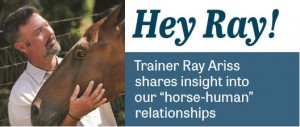 HEY RAY! This is about lost trust and resentment. I was training my horse, Connor, for trailering. Whenever he stopped in front of the trailer, I would back him up forcefully—I was trying to make the choice of either going “forward” or being “backed up forcefully.” I had thought of “backing up” as punishment. At that time, I didn’t know about SWAP and didn’t reward him for successfully backing up. Not only that, I backed him up very forcefully. If I caught up to him while I was running forward, he would get a sharp tap in the chest. Now he is resentful. How do I get him back? —Evan Moser, Lancaster, Calif.
HEY RAY! This is about lost trust and resentment. I was training my horse, Connor, for trailering. Whenever he stopped in front of the trailer, I would back him up forcefully—I was trying to make the choice of either going “forward” or being “backed up forcefully.” I had thought of “backing up” as punishment. At that time, I didn’t know about SWAP and didn’t reward him for successfully backing up. Not only that, I backed him up very forcefully. If I caught up to him while I was running forward, he would get a sharp tap in the chest. Now he is resentful. How do I get him back? —Evan Moser, Lancaster, Calif.
HEY EVAN: All is not lost. You are ahead of the game because of how clear you are about the need for change. The approach you took is one that could have worked. Many people have been successful loading horses—as well as making them do things they didn’t want to do—with punishment. Negative reinforcement will work if you’re very good at administering it and your horse is willing to accept it. If punishment brings out the worst in your horse, you will initiate a battle that, unless you win, will haunt you throughout the relationship with your horse. I feel freedom of choice is the key to your horse’s happiness. How you help him make the right choices will be what he appreciates the most about you. The approach, intention, and delivery will influence how accepting your horse will be. The first thing we need to do is put your dressage whip away. The whip, unless used properly, will only frustrate and/or insult your horse. Connor needs to understand that anything he feels from now on actually means something. Sensation or pressure should not evoke fear or intimidation. You need to come across as harmless, but enlightening, if you expect your horse to have the necessary breakthroughs needed to S.W.A.P. (Sweet, Willing, And Predictable).
One way you can accomplish this is by wrapping a small sponge at the end of your wand or stick with some electrical tape. This doesn’t need to be pretty, just functional. This way you can tap your horse all over until he becomes fully desensitized and accepting of the wand. Next, you should attempt to put meaning to sensation. The way you will do this, is by raising the volume (stepping up the pressure) every couple of taps until he moves. When he does, stop tapping and allow him to continue to move. You should be able to move your horse forward, sideways and backwards with the use of the wand with the sole intention of rewarding him at the end, each and every time. If you want him to stop, rub him with the end of the wand continuously until he stands quietly. This should help restore your horse’s negative perception of the aid, (whip) and restore the trust and confidence in you.
How you apply your aids is no different than how you initially start your car. Once you crank it over, allow it to continue to run on its own. Continuing to crank the starter would only result in damaging the system. Don’t reapply the aids until the horse stalls or stops. Then—and only then—should the aids be reinstated.
The next stage should be fairly simple now that we have your horse in a healthier state of mind. Remember, we are looking for the excuse to reward, not for the excuse to punish. If the horse does anything other then what we have suggested or hoped, we should ask ourselves: Is this something I can reward you for? If the answer is no, then find something that you can reward him for, i.e. backing, circling, or turning on the forehand with a reward at the end. Because horses are masters at reading body language, it is extremely important that you stay positive, regardless of which of the two choices your horse picks.
If you choose backing up as your rewardable exercise, try patting him under his jaw with the padded end instead of on his chest. Not only will you avoid bringing back bad feelings from the sharp whip, but you will help position your horse’s frame in a way where his withers will be up and his haunches will be down. This will facilitate the exercise. Before you try loading your horse into the trailer, see if you can challenge him by asking him to walk over a puddle, tarp or other obstacle that he might refuse.
This will give you a chance to practice and your horse a chance to succeed without the added challenges that go along with trailer loading. Trust your instincts and stay safe,
–Ray
Horsetrader columnist Ray Ariss, husband to Pippa Ariss and father of six, shares his insight into the relationship of horse-and-human each month, in print and on www.horsetrader.com.
Leave a Comment
All fields must be filled in to leave a message.